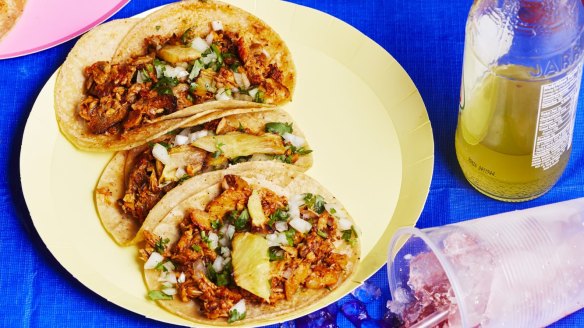Masa harina: Everything you need to know

What is it?
Masa harina or masa flour is corn meal to make dough for Mexican tortillas, tamales, gorditas and dishes such as pupusas in South American cuisine. In Mexico, corn is not only a daily staple but a food that blends national pride and spiritual identity – with an Aztec creation myth telling a story of man and woman being formed from corn by the gods.
It is made by taking dried corn kernels and cooking them with lime – a process called nixtamalization – and then grinding them in a mill to make a rough dough or "masa". This is dried and powdered and packaged. (Note, Masa harina is not cornflour, which is mainly used to thicken sauces.)
Why do we love it?
Good corn dough is both fragrant and earthy – like rocks and roses on a hot day. Masa harina is nutritious, naturally gluten free and is cheap enough to be able to play around with at home to perfect your tortillas and tamales. Much masa harina is made in the US from GMO corn, while some is made in Mexico from old varieties of corn.
Instant masa turns into a dough very quickly while other, coarser varieties require some kneading.
Who uses it?
Mexican-born Rosa Cienfuegos of Itacate in Redfern, Sydney makes masa dough and steams it in a banana leaf with a rich chicken mole made with chillies and chocolate.
She also makes a vegetarian tamale. Traditionally, tamale masa is made with pork or chicken fat, but she uses olive oil and adds cheese, poblano pepper and red sauce to the masa and steams it in a corn husk.
Cienfuegos makes an even older, pre-Hispanic dish called tlacoyo, a canoe-shaped flat piece of blue corn masa stuffed with beans and topped with a salad of nopales or cactus leaves.
Marco De La Plaza from Latin Foods in Melton, Victoria, makes 20 different types of South American empanadas every day from recipes derived from Colombia to Venezuela using P.A.N. brand harina.
How do you use it?
Mix with water to make a masa for tortillas. Lino Alvarez, a Mexican-born ceramicist from Hill End near Bathurst, co-author of The Hill End Table cookbook, says that when making masa you need enough water to get a firm yet pliable consistency but not enough to make it too soft. "There is a certain joy to be had when making masa by hand," he says. "You join the millennia of Meso Americans who have done the same action before you."
He suggests buying a small tortilla press to make tortillas for tacos, quesadillas, enchiladas and the breakfast dish of chilaquiles. These are soft-fried tortillas, cooked in a shallow dish of salsa and served with eggs and perhaps fresh cheese and sour cream.
For tamales, mix masa harina with water and fat or oil to make the masa. Add chicken, cheese, sauce, stuff into cornhusks – available from food stores – and steam over a pot of boiling water with a dozen coins jingling around in the pot. When the coins stop jingling, you need more water.
Where do you get it?
MASECA is one of the big brands, the original commercial masa harina. It is broadly available in specialty food shops and online.
P.A.N. Harina is available from small shops such as Latin Foods in Melton and Harris Farms across NSW.
Head to essentialingredient.com.au for El Maizal yellow masa harina, or if you want blue tortillas look online for blue corn masa harina from elcielo.com.au.
After more than 10 years of answering readers' vexing culinary questions, Richard Cornish is turning his focus to ingredients. Send ingredient suggestions to brainfood@richardcornish.com.au or via Twitter and Instagram @Foodcornish.
Appears in these collections
- More:
- Food
- Brain food
